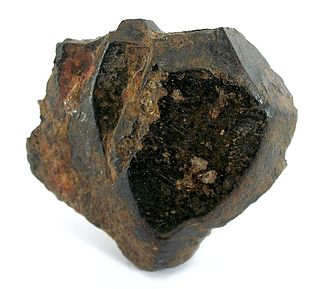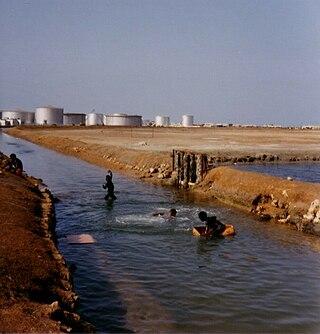Related Research Articles

Pilbara Iron is a wholly owned subsidiary of the multinational Rio Tinto Group, that manages assets for Hamersley Iron Pty Ltd, a wholly owned subsidiary of Rio Tinto, and Robe River Iron Associates, an unincorporated joint venture between Rio and three Japanese steel companies Mitsui Iron Ore Development P/L (33%), Nippon Steel Australia P/L (10.5%) and Sumitomo Metal Australia P/L (3.5%).

Iron ores are rocks and minerals from which metallic iron can be economically extracted. The ores are usually rich in iron oxides and vary in color from dark grey, bright yellow, or deep purple to rusty red. The iron is usually found in the form of magnetite (Fe
3O
4, 72.4% Fe), hematite (Fe
2O
3, 69.9% Fe), goethite (FeO(OH), 62.9% Fe), limonite (FeO(OH)·n(H2O), 55% Fe), or siderite (FeCO3, 48.2% Fe).

Ilmenite is a titanium-iron oxide mineral with the idealized formula FeTiO
3. It is a weakly magnetic black or steel-gray solid. Ilmenite is the most important ore of titanium and the main source of titanium dioxide, which is used in paints, printing inks, fabrics, plastics, paper, sunscreen, food and cosmetics.

Mining in Iran is still under development, yet the country is one of the most important mineral producers in the world, ranked among 15 major mineral-rich countries, holding some 68 types of minerals, 37 billion tonnes of proven reserves and more than 57 billion tonnes of potential reserves worth $770 billion in 2014. Mineral production contributes only 0.6 percent to the country's GDP. Add other mining-related industries and this figure increases to just four percent (2005). Many factors have contributed to this, namely lack of suitable infrastructure, legal barriers, exploration difficulties, and government control.
The mineral industry of Russia is one of the world's leading mineral industries and accounts for a large percentage of the Commonwealth of Independent States' production of a range of mineral products, including metals, industrial minerals, and mineral fuels. In 2005, Russia ranked among the leading world producers or was a significant producer of a vast range of mineral commodities, including aluminum, arsenic, cement, copper, magnesium compounds and metals, nitrogen, palladium, silicon, nickel and vanadium.

Metal production, in particular iron and steel industry, is the dominant heavy industry in Ukraine. Ukraine is the world's eighth largest producer and third largest exporter of iron and steel (2007). Ukrainian iron and steel industry accounts for around 2% of worldwide crude steel output, 5% to 6% of the national gross domestic product and 34% of Ukrainian export revenue. In 2007 it employed 420,000 people – 10% of industrial labor and 2% of the total workforce. It has the highest, by a wide margin, revealed comparative advantage of all branches of the Ukrainian economy. The industry peaked at 42.8 million tonnes in 2007 but has been gravely affected by the financial crisis of 2007–2010 and declined to 29.8 million tonnes in 2009.
The Ghelari mine was a large open pit, also an underground iron ore mine in the western of Romania in Hunedoara County, 20 km south-west of Hunedoara and 411 km north-west of the capital, Bucharest. Ghelari represents one of the largest iron ore reserves in Romania having estimated reserves of 14 million tonnes of ore. The mine produced around 200,000 tonnes of iron ore/year.
The Teliuc mine is a large open pit mine in the western of Romania in Hunedoara County, 15 km west of Hunedoara and 406 km north-west of the capital, Bucharest. Teliuc represents one of the largest iron ore reserves in Romania having estimated reserves of 3 million tonnes of ore. The mine produces around 100,000 tonnes of iron ore/year.
The Ocna de Fier mine is a large open pit mine in the western of Romania in Caraș-Severin County, 25 km west of Reșița and 511 km north-west of the capital, Bucharest. Ocna de Fier represents the largest iron ore reserves in Romania having estimated reserves of 200 million tonnes of ore grading 25% iron metal. The mine produces around 10,000 tonnes of iron ore/year.
The Dognecea mine is a large open pit mine in the western of Romania in Caraș-Severin County, 23 km west of Reșița and 509 km north-west of the capital, Bucharest. Dognecea represents one of the largest iron ore reserves in Romania having estimated reserves of 9 million tonnes of ore. The mine produces around 10,000 tonnes of iron ore/year.
The Lueta mine is a large open pit mine in central Romania in Harghita County, 36 km west of Miercurea Ciuc and 299 km north of the capital, Bucharest. Lueta represents one of the largest iron ore reserves in Romania having estimated reserves of 6 million tonnes of ore. The mine produces around 10,000 tonnes of iron ore/year.
Mining in North Korea is important to the country's economy. North Korea is naturally abundant in metals such as magnesite, zinc, tungsten, and iron; with magnesite resources of 6 billion tonnes, particularly in the North and South Hamgyong Province and Chagang Province. However, often these cannot be mined due to the acute shortage of electricity in the country, as well as the lack of proper tools to mine these materials and an antiquated industrial base. Coal, iron ore, limestone, and magnesite deposits are larger than other mineral commodities. Mining joint ventures with other countries include China, Canada, Egypt, and South Korea.
The Cacova Ierii mine is a large open pit mine in the north-western of Romania in Cluj County. Cacova Ierii represents one of the largest iron ore reserves in Romania having estimated reserves of 16.6 million tonnes of ore grading 42% iron metal. The mine has the capability to produce around 415,000 tonnes of iron ore/year.

The Karelskiy Okatysh mine is a large iron mine located in the northwest of Russia in the Republic of Karelia. Karelskiy Okatysh represents one of the largest iron ore reserves in Russia and in the world having estimated reserves of 1.29 billion tonnes of ore grading 63.2% iron metal.
The Gusevogorskoye mine is a large iron mine located in central-western Russia in the Sverdlovsk Oblast. Gusevogorskoye represents one of the largest iron ore reserves in Russia and in the world having estimated reserves of 2 billion tonnes of ore grading 15.8% iron metal.
The Rudăria-Bănia mine is a large open pit mine in the south-western Romania in Caraș-Severin County. Rudăria-Bănia represents one of the largest iron ore reserves in Romania having estimated reserves of 70 million tonnes of ore grading 45% iron metal and 20% manganese metal. The mine has the capability to produce around 500,000 tonnes of iron ore/year.
The Iron Valley mine is a small iron ore mine located in the Pilbara region of Western Australia, 75 kilometres (47 mi) northwest of Newman, 270 kilometres (170 mi) south of Port Hedland, and 10 kilometres (6 mi) east of the Yandicoogina mine.
The Gusevogoroskoye mine is a large iron mine located in western Russia in the Sverdlovsk Oblast. Gusevogoroskoye represents one of the largest iron ore reserves in Russia and in the world having estimated reserves of 2.82 billion tonnes of ore grading 15.7% iron metal.
The Berezovskoye mine is a large iron mine located in southern Russia in the Zabaykalsky Krai. Evrazruda represents one of the largest iron ore reserves in Russia and in the world having estimated reserves of 750 million tonnes of ore grading 40% iron metal.

The mining industry of Sudan is mostly driven by extraction fuel minerals, with petroleum accounting for a substantial contribution to the country's economy, until the autonomous region of Southern Sudan became an independent country in July 2011. Gold, iron ore, and base metals are mined in the Hassai Gold Mine and elsewhere. Chromite is another important mineral extracted from the Ingessana Hills. Other minerals extracted are gypsum, salt, and cement. Phosphate is found in Mount Kuoun and Mount Lauro in eastern Nuba. Reserves of zinc, lead, aluminium, cobalt, nickel in the form of block sulfides, and uranium are also established. Large reserves of iron ore have been established.
References
- ↑ Jensen, Robert G.; Shabad, Theodore; Wright, Arthur W. (August 1983). Olekma mine. University of Chicago Press. ISBN 978-0-226-39831-0 . Retrieved 2013-07-19– via Google Books.